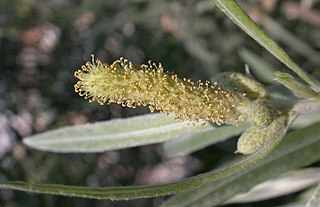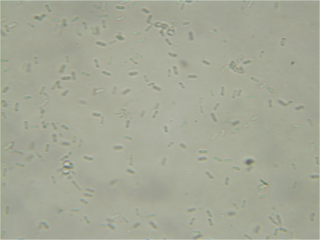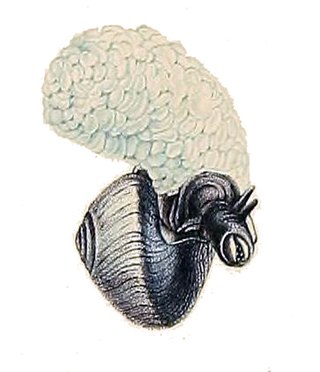
The beet armyworm or small mottled willow moth is one of the best-known agricultural pest insects. It is also known as the asparagus fern caterpillar. It is native to Asia, but has been introduced worldwide and is now found almost anywhere its many host crops are grown. The voracious larvae are the main culprits. In the British Isles, where it is an introduced species and not known to breed, the adult moth is known as the small mottled willow moth.

Cymothoa exigua, or the tongue-eating louse, is a parasitic isopod of the family Cymothoidae. It enters fish through the gills. The female attaches to the tongue, while the male attaches to the gill arches beneath and behind the female. Females are 8–29 mm (0.3–1.1 in) long and 4–14 mm (0.16–0.55 in) wide. Males are about 7.5–15 mm (0.3–0.6 in) long and 3–7 mm (0.12–0.28 in) wide. The parasite severs the blood vessels in the fish's tongue, causing the tongue to fall off. It then attaches itself to the remaining stub of tongue and the parasite itself effectively serves as the fish's new "tongue".
Carnarvonchochlea exigua, previously classified as Jardinella exigua, is a small freshwater snail residing in North East Queensland, near Carnarvon Gorge. Carnarvoncochlea refers to the location of origin, whilst exigua derives from the latin word "exigus" meaning "small".
Pterophylla exigua, formerly known as Weinmannia exigua, is a species of plant in the family Cunoniaceae. It is endemic to Fiji. This scarce shrub or small tree is known from a single population of 30 to 40 individual plants in Cakaudrove Province on Vanua Levu. It grows in forest or thicket at low elevations. Its known habitat is in at high risk of fires.

Salix exigua is a species of willow native to most of North America except for the southeast and far north, occurring from Alaska east to New Brunswick, and south to northern Mexico. It is considered a threatened species in Massachusetts while in Connecticut, Maryland, and New Hampshire it is considered endangered.

Parvulastra exigua, or the dwarf cushion star is a species of sea star in the family Asterinidae. It can be found in temperate intertidal marine communities from geographically widespread sites around the southern hemisphere.

Phoma is a genus of common coelomycetous soil fungi. It contains many plant pathogenic species.

Janthina is a genus of small to medium-sized pelagic or planktonic sea snails, marine gastropod molluscs in the family Epitoniidae.
Orthomecyna is a genus of moths of the family Crambidae. All species are endemic to Hawaii.

Iflaviridae is a family of positive sense RNA viruses insect-infecting viruses. Some of the insects commonly infected by iflaviruses include aphids, leafhoppers, flies, bees, ants, silkworms and wasps. The name "Ifla" is derived from the name "Infectious flacherie virus", a member species. There is one genus (Iflavirus) and 16 species in this family.

Madia exigua is a species of flowering plant in the family Asteraceae known by the common names small tarweed and threadstem madia.

Stephanomeria exigua, the small wirelettuce, is a perennial or biennial plant native to the western United States. It is thought to be the parent species of Stephanomeria malheurensis, an endangered plant species found only in southern Oregon. It generally blooms from mid-spring to late summer and produces small, light pink or light purple blooms.

Ponometia exigua is a moth of the family Noctuidae first described by Johan Christian Fabricius in 1793. It is found from Georgia, south to Florida and west to Texas. Outside of the United States it is found in Jamaica, Cuba, Hispaniola, the Virgin Islands and Central America and South America down to Brazil.

In the shell of gastropod mollusks, the lip is the free margin of the peristome or aperture of the gastropod shell.
Geodia exigua is a species of sponge that produces the sesquiterpene spiro compound exiguamide. The species was first described by Johannes Thiele in 1898. It is a marine organism known from Japan.

Pterolophia is a genus of longhorn beetles of the subfamily Lamiinae, containing the following species:
Eucalyptus exigua is a species of mallee that is endemic to Western Australia. It has smooth, whitish bark, linear to narrow lance-shaped adult leaves, flower buds in groups of between seven and eleven, white flowers and short barrel-shaped to conical fruit.
Pterolophia instabilis is a species of beetle in the family Cerambycidae. It was described by Per Olof Christopher Aurivillius in 1922. It is known from Seychelles.

Boeremia exigua is the type species of the fungus genus, Boeremia, in the Didymellaceae family. It was first described as Phoma exigua by John Baptiste Henri Joseph Desmazières in 1849, and transferred to the genus, Boeremia, by M.M. Aveskamp, J. de Gruyter, J.H.C. Woudenberg, G.J.M. Verkley and P.W. Crous in 2010.










